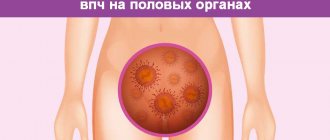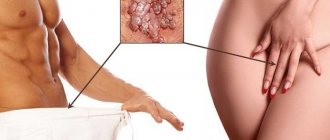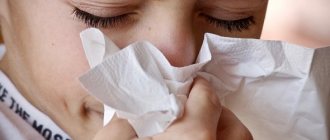The condition when a girl itches in her intimate area and really wants to scratch between her legs endlessly is familiar to almost everyone. But the burning and itching in the perineum and genital area is especially unbearable. And it’s not just about the rules of decency, which do not allow a person to ease the situation even for a while. The part of the body “below the waist” is very rich in nerve endings, and itching in the groin brings incomparable suffering. Women, encountering these sensations for the first time, almost always experience stress, as they are associated with something indecent, primarily with sexually transmitted infections...
Until now, medical science cannot clearly explain what intimate itching is. In women, apparently, this sensation appears due to very weak irritation of the nerve endings, which cannot cause “full” pain. And, oddly enough, quite serious ailments can be hidden behind this “trifling” ailment.
Causes of intimate itching in women
1. Itching in the groin in the genital area is only a symptom, and it can have many causes, and “bad diseases” are not always to blame. It may be behind pathological conditions not only of the urinary and genital tracts, but also, for example, of the intestines. Discomfort in the intimate organs in girls often appears as the first symptom of diseases such as diabetes, liver dysfunction (even hepatitis or cirrhosis), and allergic reactions.
2. Sometimes itching in the perineum appears due to neglect of the most basic hygiene rules. Alas, gynecologists often have to remind women that underwear needs to be changed every day and to give preference to products made from natural materials that absorb all secretions well.
3. Regarding daily washing. It is not at all necessary to boil water or add disinfectant solutions to it for this purpose. Regular tap water is fine. Intimate hygiene products (gels, soaps, etc.), like traditional soap, are also not necessary - this is a matter of habit and does not significantly affect cleanliness. You should not try to use soap or other hygiene products to “kill” the burning and itching in the intimate area due to “bad” vaginal discharge: they only dry out the skin and mucous membranes, and this can only make the problem worse. Vaginal deodorants in the form of foam or spray are now available for sale. They cannot be considered hygiene products; they disrupt the normal microflora of the vagina too much, increasing the risk of developing inflammatory diseases. Their deodorizing effect is fleeting and, again, does not eliminate the cause of the symptoms that bother you and the itching between the legs.
4. Quite often, irritation and genital itching without burning or discharge occur against the background of diarrhea (diarrhea) or frequent urination. If a girl’s inner labia are rather large and the tissues near the clitoris (hood and skin folds) are overdeveloped, then trips to the toilet “for minor needs” are always accompanied by splashing and ingress of urine into these structures and the accumulation of its remains in the depths of the skin folds. Even minimal errors in hygiene lead to a woman developing a persistent “urine” odor from the external genitalia, irritation and itching in the intimate area, and tests for infections will not show anything.
5. During menstruation, a woman is recommended to change pads every four to six hours, regardless of the amount of discharge. Menstrual flow is a very suitable environment for the proliferation of pathogenic bacteria, and the body’s immune defenses are weakened these days. Using pads or tampons is a personal matter, but in some cases (with inflammatory diseases of the genital organs and urinary tract, after childbirth) tampons are “banned.”
What causes itching and odor in the intimate area
Irritation, discharge, redness and itching in the perineum in girls occurs more often with the following diseases:
- Candidiasis;
- Trichomoniasis (trichomoniasis);
- Genital herpes type 2;
- Spreading HPV;
- Fungal skin diseases;
- Skin diseases (neurodermatitis);
- Pediculosis pubis and scabies;
- Violation of intimate hygiene, etc.
Very often, itching between the legs is accompanied by a disruption of the normal composition of the vaginal microflora. Among other troubles, in addition to candidiasis (thrush), gynecologists find bacterial vaginosis (gardnerellosis). Both of these diseases occur against the background of inhibition of the “good” microflora of the genital tract.
There is another diagnosis that can cause itching in the perineum - kraurosis of the vulva. The insidiousness of this disease is that outwardly everything looks fine - no local or general lesions are detected, but even with careful hygiene, itching in an intimate place can be so severe and so exhausting that it often leads to nervous disorders. The addition of an infection to skin scratching can lead to the appearance of a specific odor. Usually occurs in women of pre- and menopausal age.
Why do the labia itch?
Why do women often experience itching of the labia minora and majora, incl.
with redness and discharge. What can provoke a strong or not so strong desire to scratch the external genitalia or the area between them and what to do about it? Find out more details using the links below! assignment_ind
Find out more at the link above
Why do I want to scratch my vagina?
What are the main causes of vaginal itching and severe irritation at the vaginal opening?
Find out about the main 11 risk factors for getting this problem. How to be treated if you have symptoms and a constant strong desire to scratch in the groin - click on the link! assignment_ind
Read more about vaginal itching
Causes of itching and burning in the anogenital area
The causes of discomfort in the vulva can be provoked by both gynecological pathology and other factors.
Gynecological pathology:
- infection with fungi of the genus Candida (thrush);
- specific vulvovaginitis (gonorrhea, trichomoniasis);
- sexually transmitted infections (chlamydia, mycoplasma);
- vaginal dysbiosis or gardnerellosis;
- pregnancy;
- genital herpes;
- abortions and curettage;
- atrophic vulvovaginitis.
Perhaps itching and burning are caused by the products you use for intimate hygiene. Without identifying the causes and eliminating them, ulcers may develop in the genital area, which are quite difficult to treat. Make an appointment with a doctor and get your life back without discomfort.
Other reasons:
- allergic reactions (to detergents, fragrances, candles and lubricants);
- hypothyroidism, diabetes mellitus;
- psycho-emotional stress (stress, neuroses, depression);
- helminthiases (usually pinworms);
- violation of hygiene;
- trauma to the vulva (rough coitus, ruptures during childbirth, wearing tight synthetic underwear);
- treatment of oncological diseases (chemo- and radiation therapy);
- diseases of the digestive tract;
- treatment with antibiotics and hormones.
Itching and burning in the genital area are always signs of the development of the disease. Even if the problem disappears on its own, this does not mean that you have recovered. Unpleasant symptoms will return, and the disease will become more severe. If you have ever experienced itching and burning in the genital area, immediately make an appointment with your doctor to find out the cause of the discomfort.
Treatment of intimate itching
If you have discharge, itching and itching in an intimate place inside or outside, or other discomfort, do not delay solving the problem! To establish the cause and get rid of the disease, not much is needed ⇨ it’s to make an appointment with a gynecologist and undergo a full diagnosis. Our doctor will conduct an examination and the necessary examination, based on the results of which effective treatment will be prescribed.
Tests for itching in the intimate area
Tests will help you find out why the intimate part of a woman, a young girl, including a virgin, as well as teenagers and younger girls itches. Depending on the age of the patient, the complaints made and the result of the examination of the genitals on the chair, to clarify the cause of the itching, the gynecologist may prescribe something from the following list of tests:
- Flora smear
- PCR for hidden infections
- Bacterial seeding of discharge
- Florocenosis analysis
- Blood for hormones
- Blood for some infections
- Blood chemistry
- Scraping for oncocytology
When may irritation appear in the intimate area?
The cause of irritation in the intimate area can be a variety of circumstances. Even habitual actions that at first glance do not carry any risk can lead to a feeling of discomfort. The most common cases when a woman may experience irritation in the most delicate area:
- after shaving
. Removing unwanted hair with a razor often leads to microtrauma. Such wounds become entry points for pathogens, and irritation develops as a result of infection. A machine with dull blades is especially dangerous in this regard. In this case, the likelihood of cuts and infection increases significantly. Another risk factor related to shaving is using the wrong product to help remove unwanted hair (such as soap or shower gel); - after intimacy.
In some cases, intimate intimacy itself becomes a cause of irritation due to injury to the mucous membrane of this delicate area. But most often, irritation develops when there is insufficient lubrication and dryness of the mucous membrane, when using lubricants with flavors, or if contraception is used (suppositories, vaginal tablets, condoms with flavored lubricant, etc.), to which a woman has increased individual sensitivity or is allergic; - after taking antibiotics
. In many cases it is impossible to do without antibiotic therapy. But these drugs cannot distinguish between harmful and beneficial bacteria and strike both the former and the latter with equal force. However, the microflora of the intimate zone, which consists of many types of beneficial bacteria, plays a very important role for women's health. When their number decreases, other microorganisms begin to predominate in the microflora, in particular Candida fungi, which can cause inflammation and severe discomfort in the intimate area.
Vulvitis - symptoms and treatment
Success in the treatment of vulvovaginitis depends on an accurate diagnosis based on a thorough analysis of the anamnesis, clinical and laboratory data. Only after receiving the results of bacteriological, virological and histological studies confirming the diagnosis can therapy begin.
First of all, an anti-infective drug , taking into account the sensitivity and type of microorganism.
- For candidiasis - antimycotic drugs, such as Diflucan, fluconazole, nystatin, levorin, clotrimazole, ketoconazole, etc.
- For herpes - antiviral drugs: acyclovir, Valtrex, Famvir.
- For STDs - antibacterial drugs depending on the type of pathogen.
- For bacterial vaginosis - local antiseptics, Clindacin.
- For aerobic vulvovaginitis - local antiseptics, antibiotics taking into account culture indicators.
Treatment of patients with prolonged vulvitis is carried out jointly with dermatologists. In such cases, you can prescribe the combined local drug Tetraderm. It includes:
- Mometasone is the most powerful glucocorticosteroid (GCS) safe for local use. Has anti-inflammatory, antipruritic and anti-exudative effect.
- Econazole is a modern effective antifungal component with a bactericidal effect. Reduces the synthesis of ergosterol, which regulates the permeability of the cell wall of microorganisms.
- Gentamicin is a broad-spectrum antibacterial component used for topical treatment of primary and secondary bacterial skin infections.
- Dexpanthenol (vitamin B5) is a regenerating component with a metabolic effect. It has a local anti-inflammatory and immune effect, is included in the metabolism of skin cells and restores the damaged stratum corneum.
"Makmiror complex" is an antimicrobial combination agent containing nifuratel and nystatin. The drug does not suppress the growth of lactobacilli, so after a course of therapy, normal vaginal flora is quickly restored.
Antimicrobial therapy destroys not only pathogenic, but also beneficial microflora. As a result, more virulent infections invade and colonize the vagina, which again manifests itself as pathological vaginal discharge and vulvar irritation. To break this vicious circle, after antimicrobial therapy it is necessary to restore the flora with eubiotics - preparations containing live cultures of beneficial microorganisms. For example, you can use Laktozhinal. This drug helps normalize the pH of the vaginal microflora due to the production of lactic acid. It consists of :
- Lactobacilli LCR 35 - form a protective film, normalize the pH of the vagina, and prevent the attachment of pathogens. As a result, the stability of the microflora is restored until the moment when the biotope is filled with its own lactobacilli.
- Lactose monohydrate is a nutrient medium for lactobacilli LCR 35. Secreted metabolites by LCR 35 enhance the antibacterial effect.
Application:
- 1 drop per day (No. 21) for vulvovaginal candidiasis;
- 2 drops per day (No. 7) for bacterial vaginosis;
- 1 drop per day (No. 14) as an alternative therapy [10].
Eubiotics also include suppositories “Acilact”, “Lactonorm”, “Triozhinal”, etc.
Proteolytic enzymes enhance the effect of antibiotics . They help accelerate proliferative processes in tissues, activate cellular reactions, enhance the phagocytic activity of leukocytes, and reduce relapses of the disease. Proteolytic enzymes are contained in the Wobenzym preparation. It is resistant to gastric juice. This product contains: bromelain, papain, pancreatin, chymotrypsin, amylase, lipase, rutin. Prescribe 3 tablets 3 times a day for 1-2 months [6]. (The drug should be regarded as a dietary supplement, the effectiveness of which has not been fully proven. - Ed.)
, vitamin therapy, immunostimulants, and interferon inducers are also used [7] .
Due to the fact that prolonged itching is associated with excessive production of histamine, it is recommended to prescribe antihistamines : Suprastin, Tavegil, Diazolin, Zodak, etc. [7]. Some patients with prolonged itching do not consult doctors for a long time and try to treat themselves. As a rule, this does not help, and women go to the doctor with an already formed “vicious circle”. Such patients are recommended to be prescribed sedatives that have a calming effect [2].
Local application of estrogens restores vaginal acidity and neutralizes microbiological changes, especially during menopause, when the level of female sex hormones drops. Also helps prevent recurrences of urinary tract infections.
Vaginal use of estriol preparations reduces vaginal dryness, itching and dyspareunia (pain during sexual intercourse), and significantly improves cytological data. Estriol is a natural estrogen. He is the safest. Has no effect on the endometrium and mammary glands. Estriol contains drugs such as “Ovestin” (cream and suppositories), “Orniona” (cream), etc. For the treatment of vulvar dystrophy, estriol is used in a single dose for 2-3 weeks daily, then a maintenance dose is recommended 1-2 times a week. Moreover, only a small part of a single dose is applied directly to the vulva, and the rest must be inserted into the vagina.
It is important to understand that local estrogen deficiency is possible not only in postmenopausal women, but also in young patients with regular menstruation, therefore, with dyspareunia and recurrent vulvovaginitis, it is important to pay attention to the cytological conclusion, the results of colposcopy and keep in mind possible estrogen deficiency.
Local use of glucocorticosteroids is especially indicated for autoimmune inflammatory dermatosis. Corticosteroids have an anti-inflammatory effect and an antihyperplastic effect on the proliferating superficial layers of the skin. They have antiallergic, local analgesic, antipruritic effects. Because of the risk of scar tissue, corticosteroids are not used long-term, but may be prescribed for a short period to quickly relieve severe itching and pain in the vulva. Corticosteroids are especially effective in cases of severe inflammatory reaction and mainly in patients with lichen sclerosus [5].
Local application of androgens. It is a promising method for the treatment of vulvitis against the background of lichen sclerosus. 2% testosterone propionate in a small amount should be rubbed into the skin 2-3 times a day for 6-8 weeks. Maintenance course - 1 time every other day. However, the drug may cause side effects, the patient must be warned about this. Long-term use of testosterone can lead to clitoromegaly (abnormal enlargement of the outer part of the clitoris), increased sexual desire and facial hair growth [5].
The following surgical treatments are used: cryodestruction, radiofrequency and laser coagulation, vulvectomy. However, due to frequent postoperative complications and relapses, unsatisfactory cosmetic and functional results, these methods are abandoned in favor of less traumatic ones.
Photodynamic therapy is a high-tech method for treating vulvar dystrophy [11]. PDT is an organ-preserving treatment method. A photosensitizer is first introduced into the patient's body, which subsequently accumulates in pathological tissues (malignant, inflammatory, infected with viruses). Further, under the influence of radiation of a certain wavelength, these altered tissues are destroyed. In this case, there is minimal damage to healthy tissue, an antiviral effect, rapid tissue healing and good cosmetic results.
If the result is not satisfactory, the procedure can be repeated. At the end of treatment, the doctor can see a good cosmetic effect, an improvement in the cytological and morphological picture. The woman herself, as a rule, notes a decrease in itching, burning, soreness, dryness, increased tissue elasticity, and an improved quality of sexual life.
When performing photodynamic therapy, the patient must:
- During the day, observe the light regime - avoid exposure to direct sunlight.
- Treat the external genitalia with an antiseptic solution after each act of urination.
- If pain occurs, apply a local anesthetic (for example, Acriol Pro) to the vulvar tissue.
- Apply Tetraderm cream in a thin layer to the vulva from the second day until the tissue is completely epithelized.
- Apply Orniona cream daily at night for a long time.
- See a specialist [11].











